Brown spots on your Ficus leaves can stem from bacterial infections, fungi, or environmental stress. To treat them, first check light exposure and humidity levels, as improper conditions often trigger spotting. Apply neem oil for pest and fungal issues, maintain 40-60% humidity, and guarantee bright indirect light. Remove affected leaves and adjust watering to prevent root rot. Our thorough guide offers proven strategies to restore your Ficus's vibrant health.
Understanding Ficus Leaf Spot Symptoms
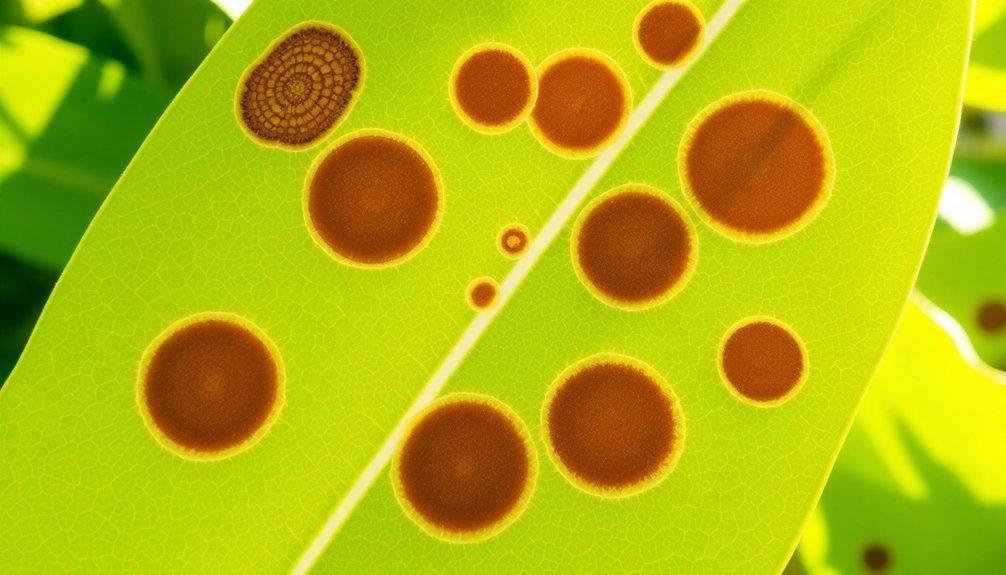
When your ficus plant develops spots on its leaves, identifying the specific type of infection is essential for effective treatment.
You'll notice distinct patterns that point to different diseases. Bacterial infections like Pseudomonas create water-soaked circular or angular lesions on ficus leaves, while Anthracnose produces necrotic spots with brown spores underneath during humid conditions.
Watch for Corynespora's signature reddish spots on newer mature leaves, which spread between the veins and can cause leaf drop.
If you see circular, dime-sized brown lesions with black rings, you're likely dealing with Myrothecium, especially in warm, humid environments.
Don't overlook nutritional causes – yellowing ficus leaves with brown spots might signal nitrogen or potassium deficiencies rather than disease, requiring a different treatment approach.
Common Root Causes of Brown Spots
Although brown spots on ficus leaves can seem alarming, understanding their root causes will help you tackle the problem effectively. Your ficus's leaf spot issues often stem from environmental factors you can control.
Brown spots on ficus leaves are manageable once you identify their causes. Most issues stem from controllable environmental conditions.
If you're noticing leggy growth alongside the spots, insufficient light is likely the culprit, and you'll need to provide brighter, indirect light.
Low humidity below 40% causes brown tips and edges, while nutrient deficiencies show up as yellowing leaves with brown spots or burnt margins.
Don't overlook pest problems – spider mites and scale insects leave telltale signs like stippled leaves and sticky residue.
Watch out for fungal infections such as anthracnose, which creates necrotic spots. By identifying these specific causes, you'll be better equipped to choose the right treatment for your ficus's recovery.
Essential Diagnostic Steps
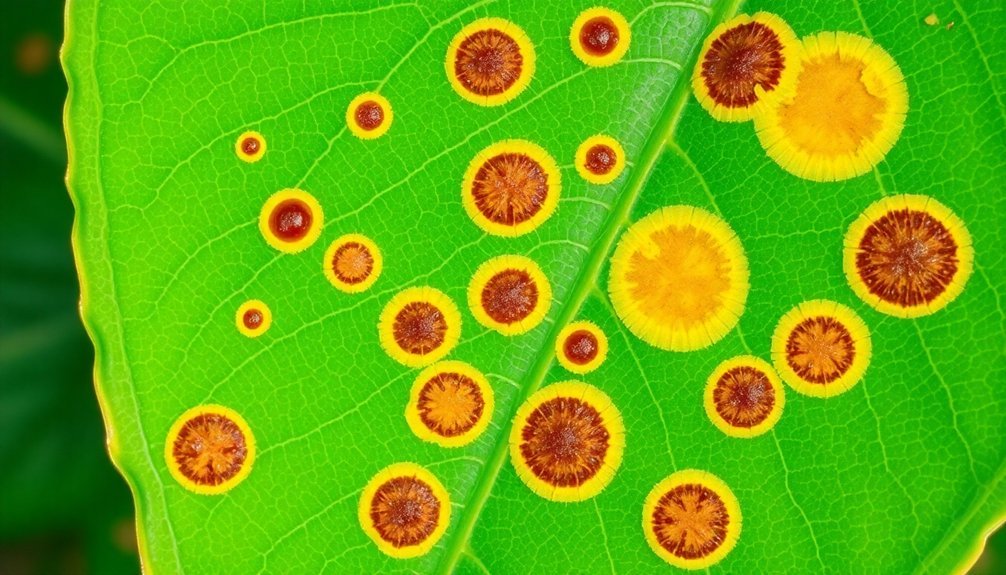
Before treating your ficus's brown spots, you'll need to conduct a thorough diagnostic assessment to pinpoint the exact cause. Your Ficus elastica requires careful examination across multiple environmental factors to determine the proper treatment approach.
| Area to Check | What to Look For | Potential Issue |
|---|---|---|
| Light | Leggy growth, scorched leaves | Poor placement |
| Humidity | Brown leaf tips/edges | Low moisture |
| Foliage | Webbing, sticky residue | Pest infestation |
| Leaf Color | Yellow with brown spots | Nitrogen deficit |
| Leaf Margins | Edge burning | Potassium deficit |
Check each factor systematically, starting with light conditions and working through humidity levels. Examine leaves closely for pest evidence and nutrient deficiency symptoms. Document any patterns you notice in leaf discoloration or damage, as these details will guide your treatment strategy.
Environmental Impact Assessment
You'll need to assess both direct and indirect light exposure in your Ficus's location, as improper lighting can trigger stress-related leaf spots and scorching.
When checking humidity levels, pay close attention to symptoms like brown tips or edges that signal your plant isn't getting enough moisture in the air.
Consider using a humidity meter to maintain levels between 40-60%, which will help prevent stress-induced leaf spots and support your Ficus's overall health.
Light Exposure Analysis
Since light exposure directly impacts the health of your Ficus, understanding proper lighting conditions is essential for preventing leaf spots.
You'll need to place your plant in bright, indirect light, as direct sunlight can damage the leaves and cause unsightly brown spots. Watch for signs that your plant isn't getting enough light, such as leggy growth or discoloration.
Your Ficus requires between 40,000 to 80,000 lux for peak growth, and lower light levels can stress your plant and compromise its health.
Remember to adjust your plant's position during winter months when natural light decreases. Keep an eye on any changes in your room's layout, such as new furniture or curtains, as these can affect light availability.
Regular monitoring will help you maintain ideal conditions and prevent light-related leaf problems.
Humidity Level Effects
While maintaining proper humidity levels is essential for your Ficus, understanding its impact on leaf health can help prevent common problems. Your plant thrives in humidity between 40-60%, and when levels drop below this range, you'll notice signs of stress like yellowing leaves and brown edges.
Low humidity is particularly challenging during winter months when indoor heating systems dry out the air. If you don't address these conditions, your Ficus may develop leggy growth and become vulnerable to spider mites.
To combat humidity level effects, you can use a humidifier or place pebble trays filled with water near your plant. Regular misting of the leaves also helps maintain ideal moisture levels, preventing leaf spots and promoting lusher foliage.
Monitor your plant's environment closely, especially during dry seasons.
Treatment Methods and Solutions
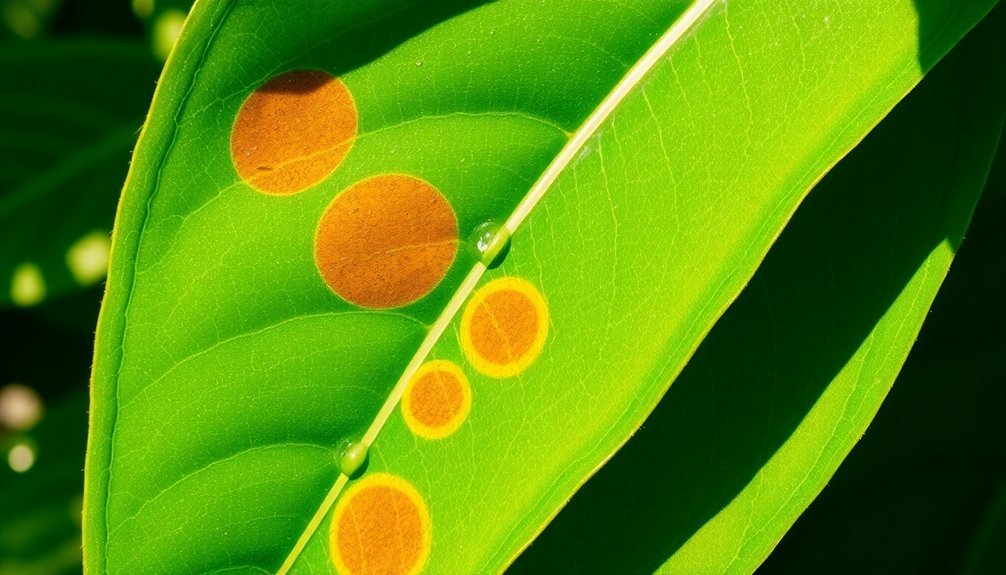
To effectively treat Ficus leaf spots, several proven methods can address both the symptoms and underlying causes.
Start by applying a balanced fertilizer in spring to correct nutrient deficiencies that cause yellowing and spots. If you're dealing with pests, use neem oil or insecticidal soap to eliminate scale insects and spider mites.
For preventive care, make sure you're using a well-draining soil mix and maintain proper watering habits. Let the top inch of soil dry between waterings to prevent root rot issues.
Keep humidity levels between 40-60% using a humidifier or pebble tray to avoid brown leaf tips. Regular inspections of your Ficus leaves will help you catch problems early, allowing for quick intervention before spots become severe.
Natural Remedies for Leaf Recovery
You'll find several effective natural remedies to combat Ficus leaf spots using essential oils and homemade treatments.
Neem oil stands out as a powerful solution when diluted properly, while a simple homemade insecticidal soap mixture can effectively target pest-related leaf issues.
Creating your own herbal treatments using mild soap solutions at 1-2% concentration offers a gentle yet effective approach to leaf recovery, especially when combined with proper environmental care.
Essential Oil Spray Solutions
When dealing with Ficus leaf spots, essential oil spray solutions offer effective and natural treatment options for your plant's recovery.
You'll find that neem oil, when properly diluted, acts as a powerful natural pesticide for your Ficus lyrata, helping eliminate pests that cause those unsightly spots.
You can create your own insecticidal solution by mixing mild soap with water at a 1-2% concentration. For fungal issues, try using diluted tea tree oil, which provides excellent antifungal benefits.
Regular application of these essential oil sprays will strengthen your plant's natural defenses against various stress factors.
Before treating your entire Ficus, remember to test any essential oil solution on a small leaf area first. This precaution guarantees your plant won't have an adverse reaction to the treatment.
Homemade Herbal Treatments
Several powerful herbal remedies can help your Ficus recover from leaf spots naturally.
You'll find chamomile tea particularly effective as a foliar spray, offering both antifungal protection and gentle nutrition to your plant's damaged leaves. Mix this botanical solution with your homemade insecticidal soap (1-2% concentration) for enhanced pest control while treating existing spots.
For additional natural healing, combine baking soda with water and spray it on your Ficus leaves to prevent fungal issues like powdery mildew from developing.
If you're dealing with stubborn leaf spots, try alternating between neem oil applications and your herbal treatments. The neem oil's dual action as a pesticide and fungicide complements the healing properties of chamomile, while essential oils like tea tree can provide extra protection against recurring problems.
Preventive Care Strategies
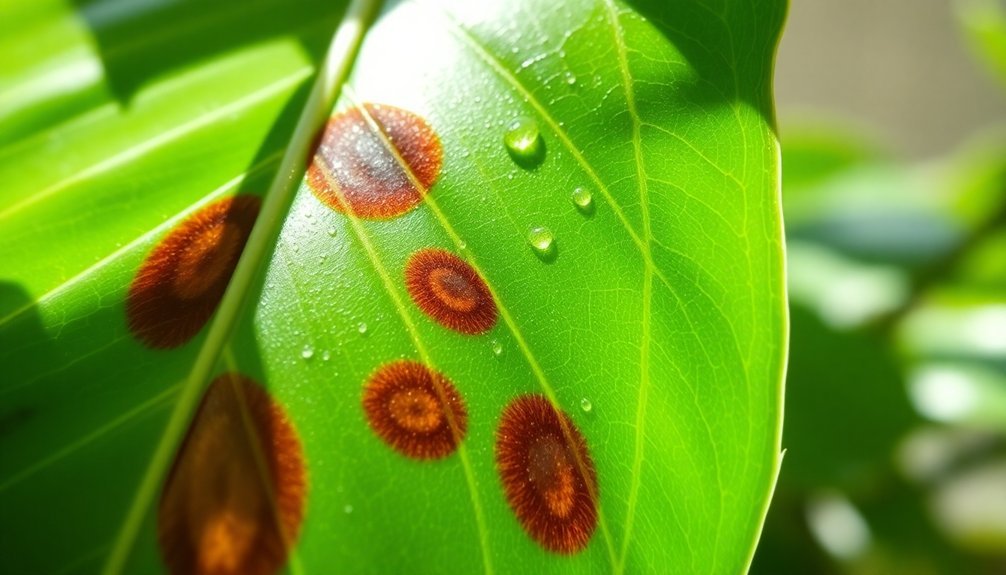
Maintaining proper preventive care for your Ficus is essential to avoid common leaf spot issues and guarantee vibrant growth.
To protect your plant, you'll need to monitor humidity levels between 40-60% and move the plant away from direct sunlight to prevent scorched leaves.
Proper humidity and indirect sunlight are crucial shields against leaf damage, ensuring your Ficus thrives in its indoor environment.
Keep a watchful eye for early signs of pest infestations, particularly spider mites and scale insects. When you spot these unwanted visitors, apply neem oil or insecticidal soap immediately.
Don't forget to trim dead or damaged leaves regularly to enhance air circulation and reduce fungal risks.
Your watering routine plays a significant role in prevention. Use well-draining soil and wait until the top inch feels dry before watering again.
This practice helps you avoid root rot and the leaf spots that often follow excessive moisture.
Seasonal Adjustments and Monitoring
As the seasons change, your Ficus needs specific adjustments to its care routine to stay healthy and vibrant.
You'll notice leaves may fall during seasonal changes, which is normal as your plant adapts to changing conditions.
During winter, cut back on watering frequency while increasing humidity levels to combat dry indoor heating.
When spring arrives, restart your fertilization schedule to support new growth.
Summer requires vigilant pest monitoring as warmer conditions attract unwanted visitors.
Follow these key seasonal practices:
- Reduce watering and fertilization in fall to prepare for winter dormancy
- Maintain higher humidity levels throughout winter to prevent brown leaf edges
- Resume regular feeding in spring, gradually increasing water as growth picks up
Monitor your plant's response to these adjustments, making small changes as needed for ideal health.
Long-term Maintenance Protocol
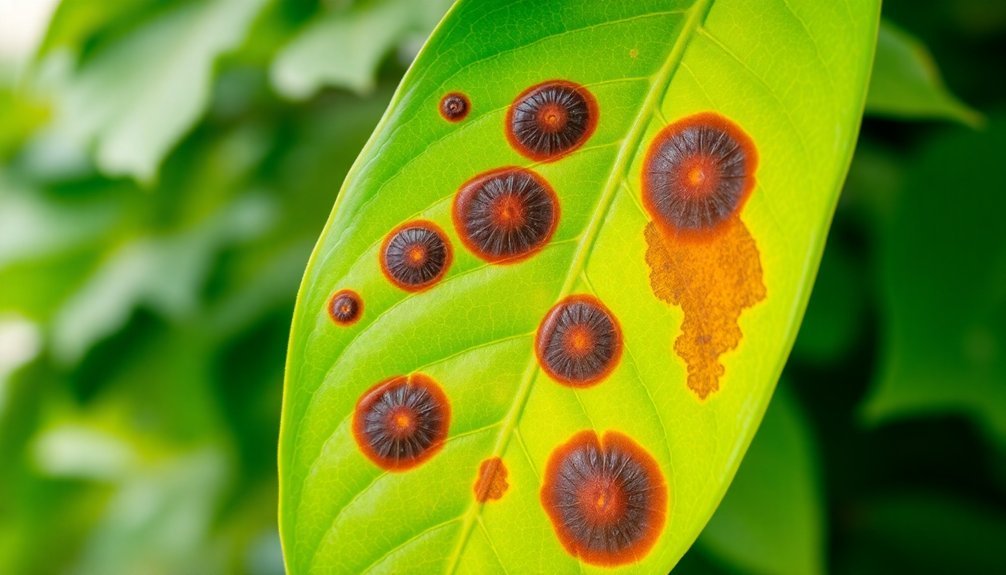
Building on your seasonal care routine, long-term maintenance guarantees your Ficus stays healthy for years to come.
You'll need to establish a consistent monitoring schedule, checking leaves weekly for yellow leaves and other signs of stress that could indicate developing problems.
Keep humidity levels between 40-60% using a humidifier or pebble tray to prevent leaf damage.
Don't water until the top inch of soil feels dry, and when you do, confirm thorough but not excessive saturation.
During the growing season, apply balanced fertilizer according to package directions to support your plant's nutritional needs.
Make pruning a regular part of your maintenance routine, removing dead or damaged foliage to improve air circulation and prevent fungal issues from taking hold.
This detailed care approach confirms your Ficus thrives long-term.
Frequently Asked Questions
How Do I Treat Brown Spots on My Ficus Leaves?
You'll need to increase humidity, check for pests, and adjust lighting. Use a humidifier, treat with neem oil if there's bugs, and guarantee bright indirect light. Apply balanced fertilizer if leaves show deficiencies.
What Fungicide for Ficus?
You'll want to use Heritage® (azoxystrobin) for leaf spots, Daconil® (chlorothalonil) for anthracnose, or Clearys 3336™ (thiophanate methyl) for root issues. Always follow the product's application instructions carefully.
How Do You Get Rid of Ficus Disease?
You'll need to monitor regularly, remove infected leaves, maintain proper humidity, sanitize tools, and apply appropriate fungicides like Decree® or Heritage®. Don't forget to isolate infected plants and avoid overhead watering.
How Do You Nurse a Ficus Back to Health?
Place your Ficus in bright, indirect light, maintain 40-60% humidity, check for pests, and don't overwater. Only water when the top inch's dry, and feed it balanced fertilizer during spring's growth period.
In Summary
Armed with expert knowledge, you're now ready to tackle ficus leaf spots head-on. Keep monitoring your plant's health, adjust care routines seasonally, and don't hesitate to act at the first sign of trouble. Whether you choose natural remedies or commercial treatments, maintaining proper growing conditions is your best defense. Remember, a healthy ficus is resilient – with your consistent care, it'll bounce back stronger.

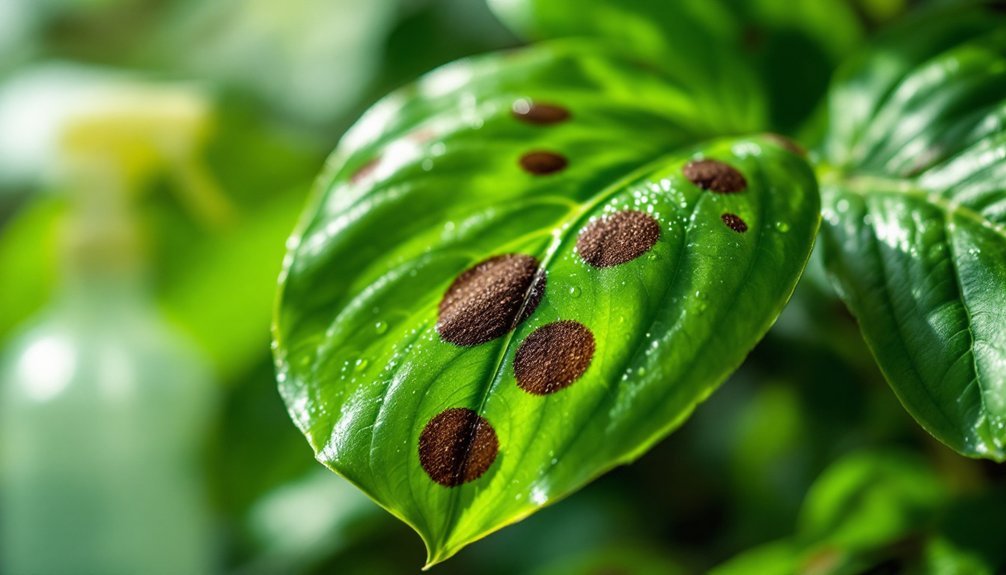



Leave a Reply